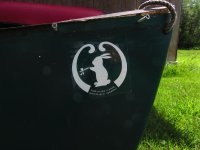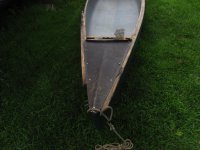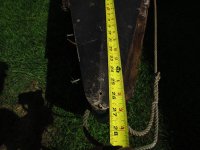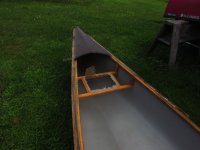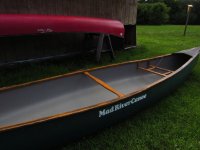Came from parts unknown with another hull to fix. All standard stuff, gunwales, seats, thwarts. Nothing hard but time consuming which is good these days. Only gripe is I cannot find a HIN on this hull. A MR...Explorer from the VT days so I know it's old school. The decks are large at 27" long which I've seen before but not often. I'm thinking the HIN is under one of the rotted gunwales, I am hoping, or this will drive me nuts. A few pics.
-
Happy National Bean Counter Day! 🫘🔢🧮
You are using an out of date browser. It may not display this or other websites correctly.
You should upgrade or use an alternative browser.
You should upgrade or use an alternative browser.
Another Fixer Upper
- Thread starter dougd
- Start date
So many boats and so little time.
We love our MR Explorer! That's a hull worthy of your talents!
Very lucky find! Quite difficult to get good deals on old canoes up here, minnow sales people grab them all and stash them at lakes n the middle of nowhere. I am currently without a poly or royalex canoe at the moment, and I find that somewhat disturbing. Anyway, have fun!
G
Guest
Guest
On this (linked) list of Mad River boat production history/years
https://www.madrivercanoe.com/us/sit...%20History.pdf
It is something of a curiosity to note that the first Explorer on that production/year list appears but briefly:
“Explorer 1975 – 1976”
Then “Explorer 16 RX 1984 – 1992, 2003 – 2010”, (and all the glass and various other composite Explorer and different lengths), then “Explorer Rx 1977 – 2006”.
Some of those “RX Explorer dates” overlap; outfitting or just different catalog nomenclature? Or perhaps a weight difference starting when MRC and other were able to order Royalex sheets with specified thicknesses in different areas for different hulls?
A 1975-1976 Explorer, which may be close in vintage with those deck plates, is guaranteed to be some beefy Royalex. I’ll be interested in the measured width of the RX at midships sheerline when you get the old gunwales off. And the thickness of the (likely black) ABS layers sandwiched between the outer vinyl and inner foam core.
I believe that those very early MRC Explorers typically had the giant 2’ long decks with a bit of deflection lip, don’t know when MRC stopped with that. Although I thought those early deck plates were stiff, flat plastic (maybe thinking early Blue Holes), and those look to be composite decks.
Those deck plates, if original, may point to an early vintage Explorer.
Now I’m curious about what differences, if any, there were between early and late model Explorers, especially any differences in the listed-separately 1975-1976 model.
Differences like “Average” weights in RX. Or dimensional changes; I kinda sorta seem to remember that early Explorers may have been deeper than the 14 ½” of subsequent models. I don’t think the RX length or width changed.
Anyone up on their early MRC Explorer history?
I’ll have to go check, but, IIRC, after some searching I found the HIN on our Explorer not etched or plated to the outside of the right rear stem, but hand written inside just below a deck plate, and near illegibly faded; best I could make out was MAD???18J?4.
Doug, out of curiosity please take a center depth measurement on that Explorer. And maybe weight it before the gunwales come off, I know how you just love hauling around 70+ lb canoes.
Funsie HIN trivia question: If not outside on the rear stern where do Canadian canoe manufacturers put their HINs?
Bonus points for other canoe MFG’s that have their HIN in different places. Or inscribed twice, one place obvious, and one place more hidden.
https://www.madrivercanoe.com/us/sit...%20History.pdf
It is something of a curiosity to note that the first Explorer on that production/year list appears but briefly:
“Explorer 1975 – 1976”
Then “Explorer 16 RX 1984 – 1992, 2003 – 2010”, (and all the glass and various other composite Explorer and different lengths), then “Explorer Rx 1977 – 2006”.
Some of those “RX Explorer dates” overlap; outfitting or just different catalog nomenclature? Or perhaps a weight difference starting when MRC and other were able to order Royalex sheets with specified thicknesses in different areas for different hulls?
A 1975-1976 Explorer, which may be close in vintage with those deck plates, is guaranteed to be some beefy Royalex. I’ll be interested in the measured width of the RX at midships sheerline when you get the old gunwales off. And the thickness of the (likely black) ABS layers sandwiched between the outer vinyl and inner foam core.
I believe that those very early MRC Explorers typically had the giant 2’ long decks with a bit of deflection lip, don’t know when MRC stopped with that. Although I thought those early deck plates were stiff, flat plastic (maybe thinking early Blue Holes), and those look to be composite decks.
Those deck plates, if original, may point to an early vintage Explorer.
Now I’m curious about what differences, if any, there were between early and late model Explorers, especially any differences in the listed-separately 1975-1976 model.
Differences like “Average” weights in RX. Or dimensional changes; I kinda sorta seem to remember that early Explorers may have been deeper than the 14 ½” of subsequent models. I don’t think the RX length or width changed.
Anyone up on their early MRC Explorer history?
I’ll have to go check, but, IIRC, after some searching I found the HIN on our Explorer not etched or plated to the outside of the right rear stem, but hand written inside just below a deck plate, and near illegibly faded; best I could make out was MAD???18J?4.
Doug, out of curiosity please take a center depth measurement on that Explorer. And maybe weight it before the gunwales come off, I know how you just love hauling around 70+ lb canoes.
Funsie HIN trivia question: If not outside on the rear stern where do Canadian canoe manufacturers put their HINs?
Bonus points for other canoe MFG’s that have their HIN in different places. Or inscribed twice, one place obvious, and one place more hidden.
I've never seen a factory MR Royalex Explorer with those long composite decks, but, then again, I haven't seen every factory MR Royalex Explorer. My guess is that those decks were added on by an owner who was frequently running whitewater in the canoe. John Berry, for example, made decks like that for his ME's, MJM's and other whitewater canoes.
The depth is 15.5" which is deeper then my Courier at 15". And good news is it is the original gunwales as there are only one set of screw holes! Yeah! Liking that!
G
Guest
Guest
I've never seen a factory MR Royalex Explorer with those long composite decks, but, then again, I haven't seen every factory MR Royalex Explorer. My guess is that those decks were added on by an owner who was frequently running whitewater in the canoe. John Berry, for example, made decks like that for his ME's, MJM's and other whitewater canoes.
I have seen a couple of very old MRC Explorers with that style deck plate, including a used boat I considered buying (no, it had dozens of cold cracks). And some equally ancient ME’s with that massive deck plate as well. Don’t know if those were Millbrooks or MRC’s.
Jim Henry and John Berry were both making canoes in Waitsfield, so there were probably some ideas if not parts and pieces moving back and forth.
It may be that those deck plates were an early Mad River factory option “white water decks”, or something folks installed aftermarket or after replacing the gunwales. When Doug gets the gunwales off it will be interesting to see if the hull shows signs of regunwaling (multiple screw holes), or if the stems show signs of once having had inset decks.
Interesting too that Doug’s old Explorer is 15 ½” deep instead of the usual 14 ½”.
I have heard, third hand and perhaps apocryphally, that some MRC models were cut down to create their progeny; supposedly the Screamer was cut to a lower depth to create the Traveler, and the Traveler cut down further still to create the (?) Fingerling.
Came from parts unknown with another hull to fix. All standard stuff, gunwales, seats, thwarts. Nothing hard but time consuming which is good these days. Only gripe is I cannot find a HIN on this hull. A MR...Explorer from the VT days so I know it's old school. The decks are large at 27" long which I've seen before but not often. I'm thinking the HIN is under one of the rotted gunwales, I am hoping, or this will drive me nuts. A few pics.
Interesting boat and decks...
I just picked up a boat advertised as a "Swift Keewaydin 16' Royalex", and was able to determine that wasn't what it was after all. Turns out there was briefly a Keewaydin Canoe Co. which was a joint venture between Stowe Canoe and Mad River (MR did the Royalex for them). Deck on mine is similar to this...but maybe a little smaller. Luckily someone had written in marker the hull number, or I might not have been able to track this down fully. I plan to replace the gunwales and decks over the winter, since it is still seaworthy now, but want to dress it up cosmetically.
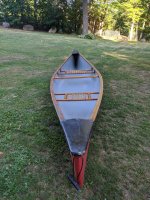
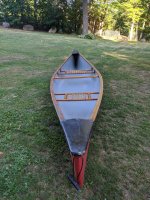
G
Guest
Guest
A bit of early canoe history with John Berry & Jim Henry, and the two “Mad River Canoe” companies in Waitsfield VT.
https://paddelblog.blogspot.com/2011/08/john-berry.html
Gotta love settling who gets to keep the MRC name with a coin flip in a bar. I didn’t know that Millbrook was named after a tributary of the Mad River.
https://paddelblog.blogspot.com/2011/08/john-berry.html
Gotta love settling who gets to keep the MRC name with a coin flip in a bar. I didn’t know that Millbrook was named after a tributary of the Mad River.
A bit of early canoe history with John Berry & Jim Henry, and the two “Mad River Canoe” companies in Waitsfield VT.
https://paddelblog.blogspot.com/2011/08/john-berry.html
Gotta love settling who gets to keep the MRC name with a coin flip in a bar. I didn’t know that Millbrook was named after a tributary of the Mad River.
That entire historical blog post about John Berry was written by me -- as told to me personally by John Berry -- copied verbatim from a post I made on the now defunct solotripping.com. At least it's been preserved somewhere. There is a link to the post but it's broken. Anyone know how to find old posts on the Wayback Machine?
On edit: I just added a comment to that German blog post.
Last edited:
G
Guest
Guest
That entire historical blog post about John Berry was written by me -- as told to me personally by John Berry -- copied verbatim from a post I made on the now defunct solotripping.com. At least it's been preserved somewhere.
On edit: I just added a comment to that German blog post.
Glenn, I remembered reading some of that history somewhere, but did not recollect where or by whom. Trying to rediscover it I Googled “John Berry Jim Henry” and that familiar-when-I-read-it history popped up.
And I say again
I like Glenn. I appreciate his long knowledge of canoes, canoeing history, paddles, paddling and the like.
Thank you both for posting this bit of canoeing history! Gotta love it and it is good to have some grizzled old veterans from the old school canoeing days here on the board!
dougd
dougd
Thanks for the link to the John Berry commentary! After learning the basics of whitewater paddling in 17’ Grumman canoes on the Lehigh River in Pennsylvania, I graduated to a John Berry closed C-1 with a Stewart Coffin fiberglass paddle. If I’m not mistaken, those two Berry C-1s are still in service with my old Boy Scout troop! This would been 1967 or 1968.
My mentors in those days were Bob McNair from the Buck Ridge Ski Club in Swarthmore, PA (USA) who wrote “Basic River Canoeing”, and Butch Rogachenko a competitive paddler who taught me the Eskimo Roll & the English Gate Sequence for practicing slalom technique.
My mentors in those days were Bob McNair from the Buck Ridge Ski Club in Swarthmore, PA (USA) who wrote “Basic River Canoeing”, and Butch Rogachenko a competitive paddler who taught me the Eskimo Roll & the English Gate Sequence for practicing slalom technique.
G
Guest
Guest
My mentors in those days were Bob McNair from the Buck Ridge Ski Club in Swarthmore, PA (USA) who wrote “Basic River Canoeing”, and Butch Rogachenko a competitive paddler who taught me the Eskimo Roll & the English Gate Sequence for practicing slalom technique.
I appreciate the phenomenon, perhaps common in any niche endeavor, that canoe enthusiasts are all but a few handshakes apart. Just within this on-line community alone we are probably one or two virtual handshakes away most of the living (some not) luminaries of canoe paddling, racing and design.
This Glenn history remembrance holds a special place for me.
His two hole tandem closed boat, the Berrigan, had multiple word plays. In one sense it was a play on Berry-Harrigan, the famous whitewater championship team for which John paddled bow. In another sense it was a poke at the Berrigan brothers, Daniel and Phillip, who were famous political activist Catholic priests in the 60’s and 70’s.
While Glenn was palling around with John Berry I was occasionally breaking bread with Philip Berrigan and Liz McAlister. And, no, I’m not still miffed that the sawhorses I lent to Philip for a Jonah House project came back destroyed without apology. Well, maybe a little; gimme time, it’s only been 40 years.
Those were some strange and interesting people at Jonah House, with a very different lifestyle. Different as in coordinating jail time so some adult was always out on bail to take care of the kids. The kids being the offspring of a Catholic priest and Catholic nun. Different.
https://en.wikipedia.org/wiki/Jonah_House
(Thanks Glenn, good trip down memory lane. If Herrigan was devoutly Catholic maybe the “poke” was aimed at him; John Berry seems to have had a wicked sense of humor)
My 1971 Old Town Sockeye may owe some heritage to the decked Berrigan, both of which Old Town was producing in the early 70’s. The hull shape is more reminiscent of a Berrigan than of any then (or since) manufactured “Tandem European-Style Touring canoe”. Love that boat as a soloized sailing tripper.
Much like the Sockeye OT’s Berrigan was a woven roving, glass and gel coat beast. 16’ x 33 ½”, and 85 freaking pounds. I’d guess not a layup weight conducive to throwing around gates in competition, so OT advertised it as “Designed for rough water cruising. Meets ICF rules. Stable in rapids”.
Old Town was making some other weirdo stuff in 1971.
That same year OT made a composite slalom kayak, the cunningly named Slalom. 13’ 1 ½” x 24”, 31 1/2 lbs. And a competition C1, the Wenatchee, 13’ 2” x 33”, 48lbs. A river in Washington State is a long dang ways from Old Town ME.
Weirder still, OT made the Surfer; a 10’ 6” x 24” decked boat with a smallish cockpit (28” x 15”, 32lbs). “Especially designed for surfing. Easy to maneuver, resists pearling”. A composite surfing kayak. . . . in 19-freaking-71.
A downriver “touring” kayak. With every possible kayak name still up for grabs in ’71 OT came up with. . . . Tourer (14’ 8” x 24 ½”). “Gives maximum speed for downriver paddling. Very fast, good in leans. Meets ICF rules”.
Even a Royalex kayak, the Snapper, identical to “Slalom”, just a little deeper and 2lbs heavier. “Vacuum-molded from rugged OLTONAR. Meets ICF rules. Can take real punishment”
It is strange to think about those slalom competition/ICF race rules hulls, short surfing boats and tandem camping cruisers that Old Town was making – checks calculator twice – 49 years ago, especially contrasted with their production models today.
That early 70’s era was kinda the overlooked page in Old Town history; sandwiched between the better known wood/canvas OCTA’s, Guides and etc, and later day RX Penobscots, Trippers & poly Discos.
Cool old-school boats.
. . . I graduated to a John Berry closed C-1 with a Stewart Coffin fiberglass paddle.
Stewart Coffin, a very interesting and accomplished man, still alive at about 90.
I met him on an AMC whitewater trip on the Lower Miller's River in Massachusetts in '83, and had no idea who he was. He was paddling a composite canoe he had made himself, the only canoe in the large group that had no flotation whatsoever, and he had no problem running the class 4 Funnel. At lunch he asked about my then new composite ME made by John Berry. When I told him I was a friend of Berry and saw him a few times a year, Coffin said, "Say hello to John from Stew Coffin."
So, later that season, I did.
John told me that Coffin was the inventor and original manufacturer of Iliad paddles, which were the first fiberglass paddles produced, as well as a renowned wilderness tripper and canoe maker. A huge proportion of the serious whitewater canoe community in the 70's and early 80's believed in magnum blade paddles with extremely strong shafts. Norse paddles were more popular in California, where I started my whitewater career with Bob Foote and others, while Iliads were more popular in the East, to which I moved in 82. I distinctly recall us digging snow, ice, mud and rocky dirt with our Iliad paddles to free up stuck vehicles on shuttle roads to rivers such as the West Branch of the Sacandaga in New York.
Coffin quit making canoes and paddles around 1968 because of the cumulative exposure to toxic fumes. He sold or licensed his Iliad molds to someone else who manufactured them for a couple more decades. He then completely changed careers and has become perhaps the most famous inventor of polyhedral interlocking wood puzzles in the world.
Here he is talking about his careers in 2018:
G
Guest
Guest
Stewart Coffin, a very interesting and accomplished man, still alive at about 90.
Coffin was the inventor and original manufacturer of Iliad paddles, which were the first fiberglass paddles produced, as well as a renowned wilderness tripper and canoe maker. A huge proportion of the serious whitewater canoe community in the 70's and early 80's believed in magnum blade paddles with extremely strong shafts. Norse paddles were more popular in California, where I started my whitewater career with Bob Foote and others, while Iliads were more popular in the East, to which I moved in 82.
Interesting stuff Glenn. Folks today who have never seen or used one would be stunned at the blade size and weight of old Norse and Iliad paddles.
I left two Norse and one Iliad paddle at the Tortoise Reserve years ago along with a couple loaner canoes. All are still there, and never used. When I get back down to NC I may grab the Iliad just as a piece of paddle history. I have zero interest in retrieving the Norse, I’d probably blow out my shoulder just picking one of them up.
What’s this thread about, again? Oh, yeah, Doug’s boat rehab. But, never mind, on to paddles:
I was on the Lehigh one day trying to paddle with the stub of a broken-shafted Expedition paddle, and not doing too well.Willy paddled by and handed me his spare, which was a Norse. That paddle worked me over pretty well, and I was talking to Willy about it later. He agreed with me but offered this: if you’re in a jam on a river and you have one stroke to make to save your life, one powerful stroke you HAVE to make, isn’t the Norse the paddle you want to take it?
I had to admit, the shaft isn’t going to snap. With the metal-tipped blade, it’s not going to crack. The blades have about ten square feet of area, so you definitely get bite in the water. And the whole paddle is so stiff that none of your power Is lost to flexing. So, ya, I’d take that Norse for the one stroke to save my life, but give me something lighter and softer for the rest of my strokes.
I was on the Lehigh one day trying to paddle with the stub of a broken-shafted Expedition paddle, and not doing too well.Willy paddled by and handed me his spare, which was a Norse. That paddle worked me over pretty well, and I was talking to Willy about it later. He agreed with me but offered this: if you’re in a jam on a river and you have one stroke to make to save your life, one powerful stroke you HAVE to make, isn’t the Norse the paddle you want to take it?
I had to admit, the shaft isn’t going to snap. With the metal-tipped blade, it’s not going to crack. The blades have about ten square feet of area, so you definitely get bite in the water. And the whole paddle is so stiff that none of your power Is lost to flexing. So, ya, I’d take that Norse for the one stroke to save my life, but give me something lighter and softer for the rest of my strokes.
G
Guest
Guest
I was on the Lehigh one day trying to paddle with the stub of a broken-shafted Expedition paddle, and not doing too well.Willy paddled by and handed me his spare, which was a Norse. That paddle worked me over pretty well, and I was talking to Willy about it later. He agreed with me but offered this: if you’re in a jam on a river and you have one stroke to make to save your life, one powerful stroke you HAVE to make, isn’t the Norse the paddle you want to take it?
I had to admit, the shaft isn’t going to snap. With the metal-tipped blade, it’s not going to crack. The blades have about ten square feet of area, so you definitely get bite in the water. And the whole paddle is so stiff that none of your power Is lost to flexing. So, ya, I’d take that Norse for the one stroke to save my life, but give me something lighter and softer for the rest of my strokes.
At least for as long as your shoulder lasts.
One of the two Norse I left at the Tortoise Reserve had been snapped, or at least raggedly broken, along the shaft. Some open boater on the Top Yough wedged it between rocks; I don’t want to say who, but IIRC we both know him.
I had both ends, cut out the raggy parts, inserted a hardwood dowel in the cleanly sawed shaft and epoxied it in place, with some Plasti-dip along the seam.
It is amazing how much of a weight difference a couple ounces of dowel and epoxy makes, even on an already heavy paddle. That thing was a beast.
We foisted that “repaired” Norse off with deserving newies on day trips down the South and Black. It was secretly referred to as “The Punishment Paddle”
No, I do not want to retrieve that one.
Similar threads
- Replies
- 4
- Views
- 922
- Replies
- 15
- Views
- 3K

